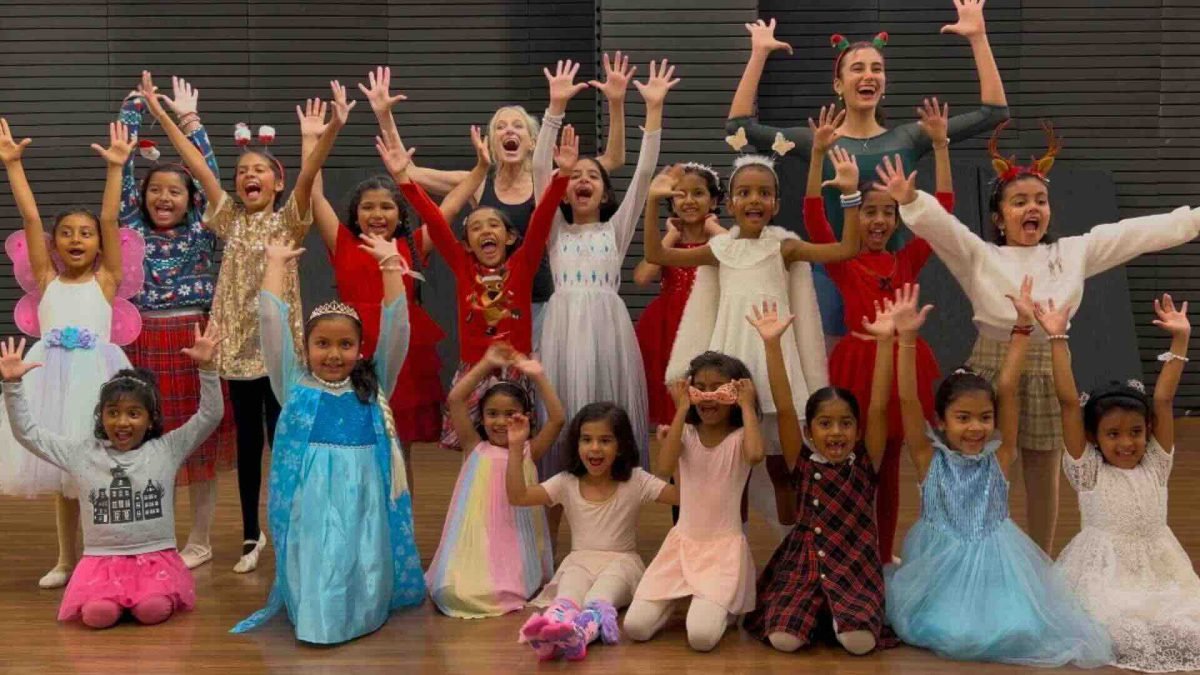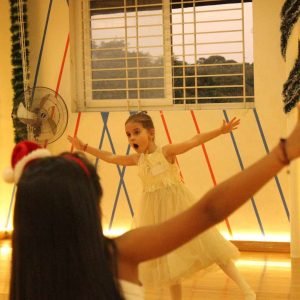By Shayna Sunu
A sense of awe struck me as I watched a bunch of tiny tots dressed in pink leotards and skirts, chattering in pairs and small groups just before their class began. Parents stood at the side, offering small words of encouragement, while the children shared giggles and carefully arranged their shoes in a neat line. All of them were ready to step into the studio, eager to see what was in store for them. And I couldn’t help but wonder what kept bringing each of them here. What sparks such excitement at such a young age? And perhaps even more surprising, what fuels the parents’ enthusiasm, waiting patiently for their little ones to return with twirls, smiles, and stories to share?
Toddlers in Ballet Skirts: What Do They Really Understand About Ballet?
Over the years, both research and practice have shown that dance, as a performing art, plays a vital role in a child’s overall development, especially when introduced at a young age. Ballet, in particular, contributes significantly to physical growth (strength, flexibility, coordination), cognitive development (memory, focus), and emotional well-being (confidence, discipline), benefiting individuals across all age groups. However, beginner ballet classes offer a unique advantage during early childhood. Elke Crowe, Director of Tutu Studios, a ballet school specializing in dance for 18 months to 5-year-olds, talks about how ages three and four are crucial developmental periods when children are most observant and impressionable. Similarly, an impact evaluation of BalletMet’s Wiggle Jig program, which integrates dance into early childhood education, found that the average number of students meeting or exceeding neuromotor goals increased from 32% at the beginning to 80% at the end of the program.
The advantages are not just limited to social development, Nicola, Co-founder of Tippy Toes Ballet (UK), notes that “One of the most rewarding things that a parent has said to us here at Tippy Toes Ballet is that their child started ballet class as a shy little person, and now they have blossomed into a self-confident little ballet dancer!” Hence, it’s extremely clear that at this stage, ballet not only strengthens their bodies but also their rapidly growing brains. These classes provide high-quality early learning experiences that go beyond movement, fostering teamwork, self-discipline, cooperation, and other life skills that extend far beyond the studio (Dev, 2023).
However, how much of ballet do young children truly understand? At this age, ballet is often introduced as an extracurricular activity, hobby or skill to explore. Children aren’t yet equipped to grasp its historical depth, formal structure, or technical rigour. What they do connect with is play, stories, music, imagination, and movement. Ballet, being a narrative-driven art form, becomes the perfect medium for storytelling. It naturally integrates the elements children relate to-pretending, expressing, and dancing, making it an ideal introduction to the world of performing arts.
That said, parents and children come into ballet classes with very different interpretations and expectations. While parents may hope for structured training and visible progress, young children are still adjusting to the unfamiliarity of a new space, new people, and a routine they don’t yet understand, causing a sense of fright or confusion. This is where the teacher steps in to lay down a shared understanding of what early ballet looks like. In pre-primary and primary levels, ballet is intentionally designed to resemble creative play to gently introduce foundational concepts. This approach keeps children engaged while instilling discipline, coordination, and focus that will grow over time.
Ballet is undoubtedly a world of wonder that can spark a child’s imagination, foster creativity, and instill a lifelong love for dance. However, as we quite often see, for children, especially those under 12, it is normal to try an activity, lose interest, and then move on to something new. This raises an important question: How do ballet teachers use creative play to create a nurturing environment that allows children to explore the magic of ballet and encourage them to keep coming back for classes?
How Teachers Make Ballet Magical
As I observed one of the pre-primary ballet classes at TLFCB, I realized how much I would have loved to be part of a group that’s asked to tip-toe, run from imagined fire, and partner up while finding different spaces in the studio. At first glance, it looked like a game or a playground, but a few more minutes in, I saw how the wiggling helped loosen their bodies, how the tip-toeing supported their growing sense of ankle coordination and balance, and how weaving in and out of spaces nurtured their spatial awareness and coordination. Every movement preparing their bodies for what ballet would demand eventually.
Ballet is an intricate dance form, highly structured, with formalized techniques and numerous positions that one must master to truly engage with it. Teachers are a crucial part of this process, as they guide students in ensuring proper form and technique, helping to prevent injuries and maximize potential. For young children, they are not just instructors but also nurturers and become a part of the immediate circle of young children, who also eventually become role models.
As I approached Ms. Elina, the ballet teacher at TLFCB, with a lot of questions and curiosity, what became most evident was the thoughtfulness behind planning each class. “Teachers need to be fully invested in it, or they (students) won’t believe you. That’s why it takes a lot of energy. But it’s also an energy exchange. We need to create that space where they can engage and that, in turn, fuels us,” she said. It became clear that her goal wasn’t just to teach steps but to help children have fun and enjoy what they did because that’s when the most learning happens.
Being fully invested, in this context, meant that teachers had to believe in and act out the imaginary world just as much as the children. “Only if I run and jump around, the kids will do the same, too.” And the children, watching her, mirrors her enthusiasm and imagination.
She emphasized that ballet, at its core, is the art of storytelling. In early ballet classes, the focus is on teaching children to be “creative with how they move their bodies.” Mime becomes a central element, where children learn to express emotions and stories through their faces and gestures. Instructions like “open and close your legs like a window” or “creep up to the door, knock on it, and run to the bushes!” not only engage imagination but also subtly build technique, working on posture, leg and foot extension, external turnout, and precise hand positions.
Props play a big role in making ballet feel magical. Scarves, wands, blocks, and soft toys aren’t random; they are essential tools that anchor attention and imagination. For example, placing blocks and asking children to jump over them helps them understand the sensation of being in the air and what their bodies need to do to get there. Giving props to characters makes them feel more real, helping children fully embody the role.
It was also interesting to hear Elina’s approach to homework, “I don’t assign any to my young students.” In her experience, it often becomes counterproductive, as some may push too hard to get it done “correctly,” taking the fun out of ballet. And when that happens, children lose interest and don’t want to return. Quite a refreshing approach, isn’t it? Dance is often thought of as something that must be rigorously practiced. But sometimes, just focusing on the joy of it is what truly helps children fall in love with the learning process.
To some, it may look like the teachers are just using a series of playful techniques to make ballet entertaining and fun for kids, however, it is based on the understanding that children think differently at various stages, which allows ballet instructors to nurture and enhance students’ learning experiences, ensuring that instruction is developmentally appropriate and engaging (Stinson, 1985). This is also why the concept of graded levels is essential in ballet, it ensures that students build skills progressively, with each stage tailored to support their growth.
The Psychology Behind Play
Engaging in conversations with the teachers at TLFCB and reading more about the process of make-believe, creative play, and prop use made me realize just how closely ballet aligns with certain concepts in psychology and techniques used for the improved development of children. As I mused this thought aloud, Ms. Yana immediately chimed in, agreeing to the connection made. To put it briefly, psychology uses techniques that help children express emotions and navigate challenges through play, their natural way of communicating. It creates a safe space where they can explore feelings using toys, stories, and imagination and this is exactly what early ballet training offers as well.
As established earlier, ballet not only supports a child’s physical development but also plays a significant role in their psychological and emotional growth. Incorporating make-believe allows children to embody different characters and stories, helping them explore emotions such as happiness, sadness, or frustration. This not only enhances emotional expression but also builds their ability to manage emotions more effectively. For instance, a teacher might say, “Okay, everyone, let’s stand tall like soldiers! Hands by your sides, no smiling, very serious faces. Now let’s start marching… left, right, left, right. Strong and proud!” Then switch to, “Now you’re a happy little fairy flying through a garden! Light feet, big smiles, arms floating like wings, can you show me how happy your fairy is?” With just these simple prompts, children learn to switch between contrasting characters and emotions, developing flexibility in expression.
Weaving in imaginative themes and scenarios, such as pretending to float like balloons, encourages children to invent movements based on creative concepts. This approach fosters imagination and expression, where role-play helps children create narratives and solve problems. It also aligns with Piaget’s developmental theory, which emphasizes that hands-on exploration leads to deeper cognitive understanding (Valentini et al., 2023).
Building on this, early ballet education also places a strong emphasis on social interaction and listening skills. These are naturally developed through collaborative activities where children must move in sync with one another. For instance, when a teacher says, “Hold hands and make one straight line,” or “Now go through the space between your two friends,” children are learning to cooperate, wait for their turn, and follow group instructions. These simple tasks foster awareness of others, teamwork, and attentive listening, skills that are essential not just in dance but in broader developmental contexts as well.
Hence, it’s quite intriguing to see how a ballet class becomes an imaginative world for young children where they feel safe and confident to try new things. It’s not just one element that keeps them coming back; it’s the combination of community, the characters they get to become, and the stories they help create and perform. It’s the consistency and the sense of wonder that motivates them to return each week, gradually integrating ballet into their daily lives.
So, parents, next time your child comes home from ballet class or you get a chance to observe them insisting on being a fairy, a king, or a princess, engage with curiosity. Ask them questions, let them twirl around a little, and step into the world they’ve imagined. You’ll begin to see how a ballet class shapes their understanding of everything around them. This is how their love for dance begins. It’s more than just learning a few steps, it’s about falling in love with movement, music, and self-expression.
And a lot of this wouldn’t be possible without the parents who consistently support their children by enrolling them in ballet classes and the teachers who thoughtfully craft each experience to make every child feel the magic that ballet can bring, not just inside the studio, but far beyond it.













Leave a Reply